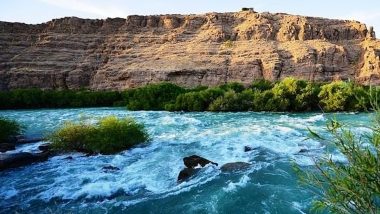Himachal Pradesh and Haryana will ink a Memorandum of Understanding (MoU) on plans to revive river Saraswati. Under the MoU, a dam will be built at Adi Badri (Haryana) which would ensure round-the-year supply to the river channel.
About the MoU
The MoU is to be signed on Friday, January 21 between the two states. The dam will be built at Adi Badri in Haryana’s Yamunanagar district, situated near the Himachal Pradesh border. It is believed to be river Saraswati’s point of origin.
A portion of the Som river, a tributary of river Yamuna (also passes through Adi Badri) will be diverted to the dam from where it will flow into the Saraswati river. Further, tourist spots will also be created along the river’s course till Pehowa (Haryana) in the first phase.
Earlier, the Haryana government had proposed the Saraswati revival project, however, it had failed to get the central government’s clearance. Himachal Pradesh CM Jai Ram Thakur Inaugurates Dharamshala Skyway Project Worth Rs 200 Crore.
History of River Saraswati in India
Considered a holy river in India, the river Saraswati also finds its place in Indian scriptures. However, it is believed to have disappeared around 6,000 years ago. Indira Gandhi National Centre for the Arts (IGNCA), an autonomous body under the Union Ministry of Culture, is also studying the river to confirm its existence.
Why the Revival?
The central government has been working towards reviving the rivers, as rivers are not only culturally important but hold civilizations together. The government has been taking up the task to clean and rejuvenate rivers through policy measures and regulations. The government has been taking various measures to meet the current water requirement, estimated to be around 1,100 billion cubic meters per year. Some of these measures include. ‘Unvaccinated Students Not To Be Allowed in Haryana Schools’, Says Health Minister Anil Vij.
– Launch of Jal Shakti Abhiyan in 2019, a campaign intended to improve water availability, conservation, and quality
– Circulation of Model Bill by Jal Shakti Ministry to states/UTs to enable them to enact suitable groundwater legislation for the regulation of its development, which has so far been adopted by 19 States/UTs.
– Central Ground Water Authority (CGWA), constituted under the “Environment (Protection) Act, 1986” for regulation and control of groundwater development and management.
– ‘Mission Water Conservation’, an actionable framework for Natural Resources Management has been developed to ensure gainful utilization of funds.
(The above story first appeared on LatestLY on Jan 20, 2022 11:36 PM IST. For more news and updates on politics, world, sports, entertainment and lifestyle, log on to our website latestly.com).













 Quickly
Quickly


